
John Cale (2018-1964): A Futurespective, The Barbican
Posted in SHOFT on Saturday 10th March 2018 at 11:03pm
It was good to be back at The Barbican. A complicated attempt to order at the cramped, circular cocktail bar aside, I was amazed at the functional brilliance of the building. As people zig-zagged around its corridors and levels to seek the correct entrance to the auditorium for tonight's performance, I decided it was a metaphor for the career we were here to appraise. For over half a century John Cale has taken sudden turns and switchbacks, has created musical landscapes which compare to the minimal concrete of the building, and has drifted in and out of mode just like béton brut. But like the solid towers of the Barbican, he has persisted in walking a difficult line between art and pop, form and function. It hasn't always appeared comfortable being John Cale over the course of the years in review in this Futurespective - but it has always sounded interesting to the listener out here.
Cale ambles onto the stage in a floating black gown, his indecently handsome features for a man of 76 years carved against the backdrop of the Barbican like a portrait of a proud Native American. Recent surgery and a leg-splint impede his progress to the keyboard, but he is all business. A drone sets up, shifting and churning as the band of people a fraction of his age and the London Contemporary Orchestra add colour. The backdrop shifts and stutters with odd projections and disquieting images. We could be anywhere between his earliest experimental compositions with La Monte Young or Terry Riley and the present day. Then the sound morphs into the familiar spoken-word strangeness of The Jeweller... The orchestra swirls, a choir joins the stage, the projections home in on a close up shot of a desperate, searching eyeball. We've set off on a tumble back and forward through time, while serene and serious, Cale pilots us from his piano stool.

What follows is a circuitous spin through a career as varied and strange as any of the curious bunch of oddballs and virtuosos who assembled themselves into The Velvet Underground all those years ago. From the formality and structure of Hedder Gabler from the mostly forgotten 'Animal Justice' EP to a surreal take on Lady Godiva's Operation adorned with shimmering electronics and shrieks of pain from sound architect Actress, the set borders on wilfully strange: Cale plays with us - taking us into uncharted waters with new arrangements of improbable songs before delivering solid, punchy versions of career stalwarts. A sharpened and honed take on Fear is a Man's Best Friend ends in howls and discordant piano hammering which seem impossibly passionate and desperate from the older, wiser Cale who is performing them. He draws surprisingly heavily on the 'Fear' album from 1974, sandwiching the critically less well-regarded but sublime pop of Caribbean Sunset between the edgy, glances-over-the-shoulder of paranoia from his earlier record. There are unlikely surges forward in time too - not least to the shuddering soundscapes of Wasteland from 'Black Acetate' where Actress against steps forward to augment Cale's composition with deep electronic growls and shudders.
Twice during the show Cale steps unsteadily but defiantly out from behind his piano and straps on a guitar - once for a searing Heartbreak Hotel and then for a closing encore of the familiar show-ending ensemble of Gun, Pablo Picasso and Mary Lou. All of this could have seemed like another turn around the same old songs, another self-congratulatory retrospective - but it didn't. Perhaps it was the orchestra providing spare, delicate accompaniment, perhaps it was the energetic band which showed respect for the material but never so much that it sidelined them into parody? The reason why this didn't feel like another ancient rock turn doing his bit became perhaps most apparent in an unexpected moment ... The presence of the choir of almost irrepressibly joyous voices came to the fore most prominently in the yet-to-be-recorded gospel of Pretty People, a thundering, enervating call to 'Rise up!' which Cale was trying out and feeling his way around just like a band of youngster's might do with new material just up the road in a grimy Hoxton back-room.
John Cale left the stage with a wave and a nod, feedback howling while the assembled cast of musicians waited, apparently stunned by what had just occurred. I got the sense that this wasn't any sort of ending - and was certainly nothing like the kind of through-the-motions plod which other acts of Cale's vintage indulged in with depressing regularity. It wasn't easy, simple or predictable - and in fact it probably probably represented yet another beginning in a career of improbable twists and remarkable musicianship. It had been a privilege to be present for this.
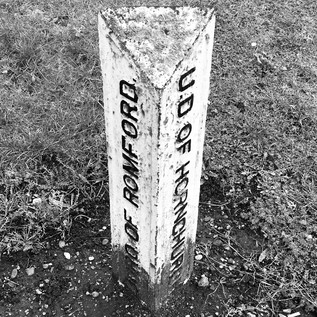
Out of the Voracious Sump: Walking back from Essex
Posted in London on Saturday 3rd February 2018 at 11:02pm
A steady rain was falling on the shining pavements of Upminster. Not heavy enough to make me pause in my plans for the day, but equally showing no sign of relenting any time soon. The trip out here from the city had been convoluted, but had passed surprisingly quickly and without any major disruption, and I was setting out a little sooner than I'd expected into the damp town centre. I'd never been to Upminster before. I'd certainly passed through: on trains scudding out to the coast, or on long meandering walks along the nearby Ingrebourne River - but I had little preconception of what I'd find at the top of the station steps. Somewhat unexpectedly, Upminster had the air of a prosperous small town. A smattering of the right kind of stores peppered the parades of interwar red-brick suburban shop-fronts flanking the street, breaking up the usual aromatic mix of takeaways and hair salons which are never far from a station. I was heading for the crossroads at the centre of Upminster where the A124 begins its journey into London from this almost-Essex town turned dormitory suburb. The ancient centre of a village with a long, distinguished history of being on the edge of a relentlessly growing London, Upminster was dragged - administratively at least - into its gravity in 1965. But the place still feels, and to some extent looks, like a market town in rural southern Essex. Squeezed by the statutory girdle of the Metropolitan Green Belt to the north and south, it edges out towards the M25 and even breaks the membrane to stray a little beyond. The District Line quits at Upminster having reached here in 1902, while the parallel tracks of the London, Tilbury & Southend Railway are left to continue the journey east. In fact, the District Line tracks struggle on for a further mile or so beyond the station into the vast depot at Cranham, near where the majority of the TfL-commissioned red buses also give up and turn back west. Upminster grew dramatically after the coming of the railways, blossoming again between the wars to become the de-facto district centre for the sprawl of new residential suburbs here at the edge of Greater London. As such it has perhaps never been well to do in the strictest sense, but today at least it certainly felt like it was doing well enough among the liminal uncertainties of 2018. I passed numerous well-dressed young folk heading for the station, drawn in by the train into 'town', though there were perhaps surprisingly few non-white faces peering down at the screens of 'phones and tablets. This is another boundary - a distinct zone where London's legendary diversity peters out entirely. Upminster didn't appear to suffer the bitterly proud, BREXIT-stoked racism of Dagenham or the knife-edge tolerance of Barking's complex population mix. Here it was just olde-England's shire-county conservatism accidentally straying into the edges of the city. I surveyed the corner up ahead with some trepidation. To the east was Essex - and Waitrose of course - but to the west was the massive, brooding imposition of London. A huge gravitational drag along the busy A124, an old road which has wound in from Essex for hundreds of years. Today I was using it as the pretext for a walk in from the edges. A return to the east which felt long overdue. If I started walking, I knew I'd feel the sense of another project underway. I recalled Jonathan Meades closing remarks in The Joy of Essex about the county's ability to consume and reclaim, not least referring to the absorption of whatever London cast out, and wondered quite where this walk would take me?
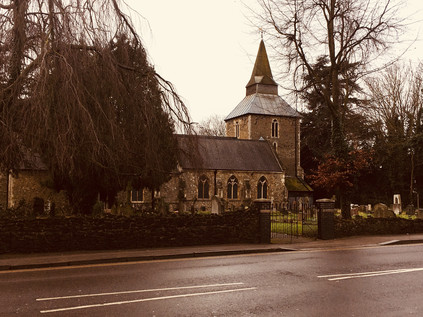
To the south of the crossroads, the squat tower of St. Laurence's Church loomed over the highway looking every inch the rural parish church despite the presence of a busy branch of Lidl nearby. From the tower of St. Laurence in 1709 the Reverend William Derham made remarkably accurate measurements of the speed of sound by way of a telescope and the flash of a distant gunshot, timing the report with a half-second metronome. These scientific pursuits seem a strange kind of work for a country parson, but it seems he was perhaps no ordinary cleric. Derham's written work fuses his theological and philosophical arguments with a surprisingly open and naturalistic mind, describing nebulae, natural variation in species and distant star clusters in his effort to forge a tangible Physico-theology. Resting near Derham in the churchyard, and like him with no memorial is Alice Perrers, mistress of King Edward III - a popular monarch in his time who seemed to fall out of favour with modern historians for not foreseeing the part his legacies would play in dividing York and Lancaster after his passing. The fact that he took no mistress until his consort, Philippa of Hainault, was terminally ill displays rare royal restraint for the period. The quiet of Derham and Perrers' repose was challenged by the steady westward stream of traffic which fussed and boiled to navigate around the regular procession of buses starting their journey back towards Romford. As I passed by, an older lady tripped and fell at the bus stop outside the church with the sickeningly specific sound of a crumpling body hitting concrete. A car screeched to a halt and someone was soon helping her back to the seat. She patted the helper away, protesting that she was fine and had just slipped. It was hard to tell if the dusty but otherwise seemingly unharmed woman or her good samaritan was more embarrassed by this un-British display of kindness - but it made clear that I was not in London. Somewhere between here and the city the tone changed and any unusual happening or public mishap was a non-interactive spectacle, a situation worthy of recording but not of intervention. Uncomfortably, I realised I'd just done the same - and so I moved on.
While the sprawl of suburbia along the A124 meant that little of the substantial swathe of greenbelt surrounding Upminster reached the margins of the road, there were still distinct divisions between the former towns and hamlets which straggled along the road. As I left Upminster, passing the windmill which has remarkably survived since 1803 but is currently shrouded in white for repairs, I began to descend into the valley of the Ingrebourne. I had briefly passed this way before, emerging from the farmland to the north to pass under the railway and head south towards the Thames. This time I was crossing the territory from east to west, and thus I was far more aware of the deep groove carved over the millennia by this apparently modest little river. The bridge here was first recorded in 1375, and the current brick bridge is at least the fourth on the site, dating from 1892 and once complete with cast iron sidings from the Whitechapel Bell Foundry. At times a ford supplemented the bridge, such was the importance of the route. But now the crossing was easily missed, with most assuming that the nearby Upminster Bridge station on its high brick viaduct was the origin of the area's name. Remembering the short strip of shops here I popped in to stock up for my walk, and emerged to find the rain slowing somewhat. Encouraged, I struck off westwards again, crossing Hacton Lane - which formerly led to the now almost entirely absent hamlet of the same name. At the crest of the hill the tall verdigris-covered spire of St. Andrew Hornchurch announced my crossing into a new parish. At the eastern end of the building, a stone bull's head pointed its horns back east - an 18th century addition, with the name of the area long-predating this somewhat literal interpretation. Despite the presence of the usual range of High Street ubiquity, there was a sense of something ancient about Hornchurch. The mock Tudor villas which had stretched along the road behind their well-kept but traffic-battered gardens petered out a little outside of town. Their faux-historical take on the old vernacular was overshadowed somewhat by the presence of the genuinely venerable, haphazard tumble of the Kings Head - now occupied by Prezzo who have shown remarkable restraint in preserving the building's dignity. But Hornchurch offers a rather more distant link to pre-history, being the most southerly point in Britain which sheet ice reached during the last ice age some 450000 years ago. The ancient geology is reportedly best seen in the railway cutting which carries the rather quiet Overground shuttle service from Upminster to Romford, where layers of geological detritus carried from the Midlands by the advancing ice can be found above the native Essex clay. The town centre of Hornchurch bustled and rushed, apparently unaware of its historical importance, centred on a knot of roads linking the suburbs to the north and south. I paused for coffee here, watching the comings and goings of the locals. Perhaps more than Upminster, this felt like a place distinct from the surrounding city and suburbs - a busy town which could perhaps be anywhere in England. That said, it was clear that the area owed much of its prosperity to the gravitational pull of London, with a steady stream of pedestrians headed briskly south towards the station as I looked out over town. If Hornchurch had been plucked up and deposited in the Midlands by some trick of the retreating ice, it would no doubt have struggled to survive.
Underway again, the road took me briefly into green space at last, dipping to cross the tiny Ravensbourne near Abbs Cross Lane. This brook hadn't featured in my previous walks - largely because much of it runs through the back gardens of suburban homes and other inaccessible places, meaning little of its relatively short length is walkable until it reaches the lake in Harrow Lodge Park near its confluence with The Beam. The road here was busy with speeding traffic navigating the curve and rising away from me in a cloud of spray and fumes. I paused in the steady drizzle to snap a picture of the tiny watercourse hemmed into a weed-choked concrete channel under the road, and incurred the interest and apparent displeasure of a passing local laden with Sainsbury's bags. He passed me, tutting and muttering although I posed no obstacle to him, then frequently looked back, suspicious of my motives in photographing the stream. As I made the steady climb away from the Ravensbourne, the rain began to fall more steadily. I was already soaked through and decided not to let it bother me. The road plunged into dreary and damp suburbia again - a long stretch of housing filling the spaces between the old towns of Essex which had once been prime farmland. I trudged on, wondering if this walk was just too contrived and obscure to really have a focus? How could I connect these disconnected blips of population which huddled along the District Line for safety? It was easy to feel discouraged in the gloom and damp, the only diversion arising from the need to move deftly to avoid being splashed by passing vehicles. Few people were around, and faces gazed at me from warm, comfortable cars in disbelief. Why would he walk out here? No-one walked out here.

And so I found myself back in Romford. My route skirted the southern edge of the town, passing the site of the former Roneo works, now a vast retail development which nestled into the corner where the main roads met the Beam River where it emerges from its largely unremarked passage under the Town Centre. The area around the former works site is a confusion of closed cafés and repurposed shops now doubling as offices and builders' merchants. It's clear that the departure of the factory, a huge employer locally, had left this outlying corner of Romford beleaguered and purposelses. The river plunged underground again to negotiate the busy junction with the A125, though its disappointing trickle could be seen in a deep concrete trough curving north alongside the road through the grounds of the vast new Queen's Hospital. South of the junction, the stocky and purposeful tower of YMCA's Thames Gateway building loomed over the otherwise flat landscape of the Beam Valley. My last passage through this area, when walking along the river, had been on a brighter spring day when a swift crossing of the road had soon seen me back in the relatively rural edgelands of Grenfell Park. Today though, my route lay to the west. As I headed away from Roneo Corner I spotted an old boundary marker driven into the ground dividing the former Urban Districts of Hornchurch and Romford. Much had changed on the ground since these divisions were laid down along the routes of ancient roads and rivers, and it was strangely cheering to see this vestige of the past persisting among the churn and change which surrounded it. With much of the traffic barrelling away towards the centre of Romford and onto faster routes into London, the road became something of a suburban backwater here: a long avenue stretching west through Rush Green, with ranks of dustbins and bare trees stretching into the middle-distance. The rain was falling steadily now from a swirl of grey cloud which showed little sign of moving on. This felt, perhaps unfairly, like a grim spot - a route which connects nothing with nothing. Persisting despite the gloom which seemed to descend as I walked further, I soon found myself passing the gates of West Ham United's training ground and beyond it the park where the Wantz Stream had been dammed to form a boating lake. There is little above-ground evidence of this once surprisingly long stream aside from its much truncated ramble through scrubby parkland to meet the Beam, so this hint of its former presence was welcome. The former crossing beneath the road was also evident from a low railing on the southern side, which once featured a coloured plaque bearing the arms of Essex. Beyond the fence a tangle of wild grasses and bushes described a narrow backfilled channel between the houses of Rush Green Road and the low-rise flats of Widsons Close. The culverted stream had been co-opted as additional garden space, and was cluttered with tumbling sheds and tarpaulin covered cars. Approximately at the point where the river would have passed beneath the road stood large signs welcoming me to Barking and Dagenham, with the squat remains of another Coal Duty Post nearby. The Wantz Stream still performed a civic duty in providing this boundary, long after its more prosaic work was consigned to the underworld. I crossed the hidden river, wondering what life would be like on this side of the intangible divide?
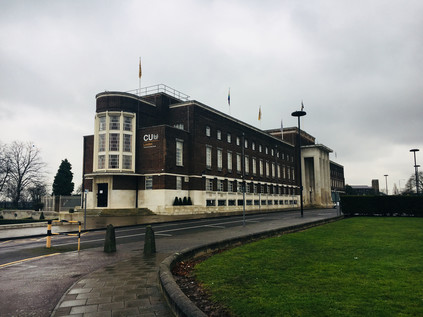
My first impressions of entering the Barking and Dagenham from this new angle were not positive. Wood Lane was a litter strewn and windy chasm leading west, away from Central Park. The development of this area had been carefully planned, but the expected approach was very much from the west. Therefore I first encountered the imposing modernist hulk of Barking and Dagenham's Civic Centre via the less impressive northern shoulder - a rank of white-painted stone window mullions dividing the slab of brick and Portland stone, relieved by a curved glass stairwell on the flank. It was a solid, clean-lined and functional building which looked surprisingly elegant from an advantageous angle, set in a wide and open area which placed it in odd isolation. A chill wind whipped in from the Thames, swirling litter and builder's dust around the grass and flowerbeds which narrowed into a roundabout up ahead. The building was conceived by architect E. Berry Webber as a statement entrance to the nearby Becontree Estate and was ready for use by 1937, roughly contemporary with the completion of the main phases of housing. Webber went on to propose similar plans for Hammersmith's Town Hall very soon after work here was done - but his plans there have been greatly modified by unsympathetic extensions and curtailed by the building of the Great West Road. By contrast, Dagenham's Civic Centre stands now looking largely as it had since opening, despite some less elegant but not overly intrusive 1960s additions. It also appears from the strength of feeling when austerity threatened its continued use, to be a much loved local landmark. On that basis, I was curious what the locals thought of its recent reincarnation as an outpost of Coventry University? Provincial educational establishments gaining a foothold in the capital appears to be very much the done thing now, but taking over a popular local landmark is a bold and ostentatious move. Pondering this land-grab, my route now led away from the Civic Centre, giving unexpected views back across the building and its approaches, which from this vantage bore an unlikely resemblance to a North American High School. The views ahead were decidedly British however as I trudged by the bulky, drab tower of Laburnum House and into the edges of Becontree. This vast estate was developed between 1921 and 1926 on compulsorily purchased former market gardening land, in order to rehouse families from cleared slums as part of a post-war drive to provide homes fit for heroes. Wood Lane, an ancient route which turned south at Becontree Heath, still describes an arc around the bounds of the original development of nearly 24,000 homes which was extended twice before finally reaching nearly 27,000 dwellings by its final completion in 1951. The estate has, at various times, vied for the prize of being the biggest development of housing in Western Europe. Despite the sheer size of Becontree, there is much to recommend about the homes here - solid, mid-century municipal designs which have lasted well, and which are arranged around a reasonable quota of green space. The first tenants of Becontree moved into an isolated, muddy morass with no extant services and a temporary railway running along the future route of Valence Avenue to bring materials to the building sites. Later though, the estate prospered in part due to its proximity to the Ford Works and the belt of industry along the Thames. Initial tenants were carefully screened for suitability by the London County Council, with their standards of hygiene and continued employment a key factor in securing one of these modern dwellings. While the Housing Act of 1919 permitted the LCC to develop these areas and act as landlord despite it being outside their turf, the administrative position around the estate and its cleansing and services remained complex until Local Government Reorganisation unified responsibilities for the site in 1965. Prior to that, various parts of the land fell into the districts of Ilford, Barking and Dagenham with the attendant confusion around schools and services requiring a range of exceptions and easements. While many homes here had long since been purchased under the right to buy rules, there was still a sense of being on a vast estate, and as I deviated from Wood Lane into the midst of Becontree, I was struck by the uneasy feeling of being somewhere which felt very familiar from my own upbringing in the Midlands. The long, straight boulevards of Valence Avenue and Becontree Avenue crossed at the midst of a cluster of local shops which were a little tired and typical, but which were still pleasantly busy. Becontree appeared to be soldiering on through these difficult first months of the year - a little tired, a little wet - but still here.
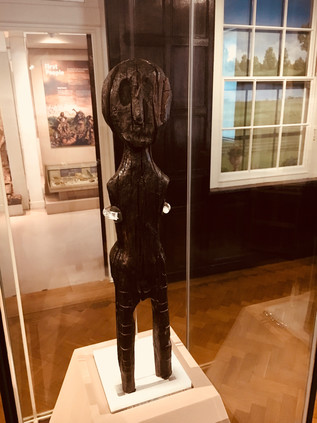
In the midst of Becontree though is a remarkable survival of all this civic and social change. Valence House was first recorded on this site in 1269 as one of the five ancient manors of Dagenham, with the current building noted as standing from around 1400. In 1921 the house, complete with a moat, was still serving as a family home - before being used by the LCC as its local headquarters during the building of Becontree Estate. Between 1928 and 1937 the house served as Dagenham's town hall until the Civic Centre was ready for business at which point the Libraries Department took on the building. The house is now a local history museum, sitting at the north-western corner of the busy park with a small remnant of its moat still separating it from the car park. I skirted the impressive new visitor centre, complete with a sculpture of a rusting Ford Capri marking Dagenham's link with this ubiquitous example of 1970s style, and headed directly for the house. I'd finally come to see something which I'd read about and had been curious to find for some time - The Dagenham Idol. Pulled from the marshes when sewers were being laid along Ripple Road in 1922, the idol is an eighteen inch tall human figure carved from Scots Pine. It was found by workers near the site which was to become Ford's sprawling riverside works, buried next to the skeleton of a deer which was possibly part of the same offering. Carbon-dated to around 2250BCE, the statue pre-dates the construction of Stonehenge and lay undisturbed in a preservative layer of peat awaiting its twentieth-century rebirth. While the rest of the displays at Valence House appeared interesting, especially those about the development and domestic arrangements of the building over the years, I was desperate to see the Idol for myself. After a show of the correct hands-behind-the-back-and-looking-up museum protocol on entering the quiet parlour I turned to the east and found myself looking history directly into its oddly oversized eye-socket. The idol is housed in a glass case in the centre of a panelled area which would once have been one of the fine reception rooms of the house. It gazes perpetually across to the west, eyeing the development of the great city of which its owner may possibly have been a founder. I circled the statue, enchanted by its great age but strange familiarity. It felt curiously appropriate that it had been brought here from its long, solitary home in the marshes into the midst of what had become this vast estate with its apparently unparalleled press of humanity. Would Becontree survive as long as the Idol? It was difficult not to superstitiously link their fates. The idol had reversed Meade's premise and made it out of the "voracious sump" after all.
It was hard to leave the quiet precincts of Valence House and the warm and inviting cafe at the visitors centre, but I needed to make progress and I was aware that the rain seemed to be slowing me down. I left the park and crossed the centre of the estate, aiming for Bennett's Castle Lane - mostly because it described an organic, twisting path on the map through the more regular geometries of Becontree, betraying its pre-estate origins. The lane is marked on early maps of the area, curving roughly southwards towards Longbridge Road - the continuation of the A124 from Wood Lane. The origins of the name are obscure - though on the 1894 revision of the Ordnance Survey map there is both a Bennett's Castle House east of the road near Valence House, and a separate Bennett's Castle nestled into the junction with Longbridge Road. There are no specific records of any sort of fortification - though if the name weren't clearly much older it would be tempting to link it to local industry via Henry Ford's notorious security chief who built a fortified 'castle' in Ypsilanti, Michigan. The lane also marked the boundary between Ilford and Dagenham, a fact blurred by the development of Becontree and erased by the redrawing of Borough boundaries in 1965. Now, Bennett's Castle Lane winds its way towards the edge of the estate in unremarkable style, arriving at the corner which appeared once to have provided its name with little ceremony. I was back on the A124 as it once again became a surprisingly quiet avenue.
Longbridge Road takes its name from a crossing of the little Mayes Brook which, if old maps are to be believed, was well-named. The road appears to run directly above a long, broadened stretch of the water before they part, with the brook heading south towards the Thames. I'd been here before - on a bright winter morning tracing the now largely hidden path of the brook through the urban developments which have filled the once open countryside. The busy curve of road where Longbridge would have crossed the brook is now a difficult to navigate junction beside the Parkside Community Centre. My progress across the street was watched with interest by a small group of locals sheltering and smoking in the lee of the centre like ceremonial guardians for the long-deleted bridge. The brook rose again south of the road in Mayesbrook Park, but my route continued to take me west, passing long, rather fine looking blocks of municipal housing set back from the road. This area appeared to have been developed in the 1930s, with Faircross - where the road south to Upney intersected my route - developing from a tiny hamlet into a busy local shopping area. The walk here was tough going - I was thoroughly soaked now, and the route into Barking seemed endless and unrelenting. I finally arrived at the huge roundabout marking the fringe of the town centre where a modern bypass takes much of the traffic which once passed through the centre of Barking in a northern arc. At the midst of the roundabout was one of the few notable pieces of public art in the district - The Catch - two delicate, silvery metal fishes leaping from the ground in celebration of the historic local fishing fleet, long since decamped to the North Sea. As I crossed the complicated pedestrian route to reach the town centre, I was accosted by perhaps the least successful beggar I've ever encountered. "Gimme one pound cash brother!" he exclaimed, and I turned to see a gentle-featured but huge black man towering over me, his palm extended hopefully. I genuinely had no cash and told him so, but he trailed silently along behind me his shoes flapping at the pavements. From a little way behind me as I paused at a crossing I heard "Gimme one pound cash sister!" - and suddenly the woman whose loud cackling into her mobile 'phone I'd been studiously ignoring turned on him: "Get a fuckin' job, I don't earn money to give it to you, how fuckin' dare you ask me for money. Go to the job centre! Fool!". He didn't seem to find the outburst surprising and padded off along a side-street, lured in by a promising looking crowd hovering outside a takeaway. She strutted away towards town, loudly complaining into her 'phone that anyone would have had the audacity to ask her for money. She held the device away from her face, yelling her disdain into the void between her and the microphone. I slowed my pace, wanting to let her disappear into the busy crowds of Station Parade so I could forget how her twisted, angry mouth had looked as she'd spat her words at the clearly vulnerable and compromised man.
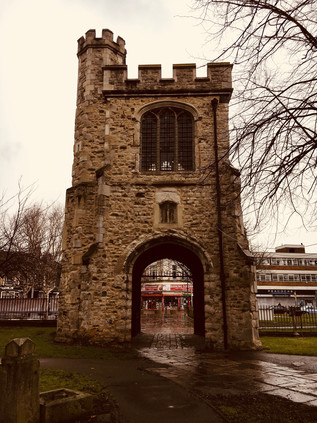
There was a time that Barking was just another stop on the railway for me - a point where routes converged and carefully planned changes between lines were possible. In recent years though, it has become a repeatedly visited nexus on my walks: a crossing point on my journey around the North Circular and a staging post on my walks along the A13 and the River Roding. The Town Centre in particular is all too familiar - a busy, edgy churn of buses and people. Today I passed directly through the centre, finding dodging through a crowd rather challenging after a day of almost solitary walking along damp, suburban avenues. Barking feels like a frontier town - where the attitude and frustration of London crashes onto the calmer shores of Essex. Beyond here, as I'd seen, there were distinct towns and communities, but Barking has been almost completely absorbed by the city - and thus shares in its benefits but shoulders a perhaps unjust burden of its misfortunes. The town is a vestige of a mid-century redevelopment, the busy open-air market wedged into a broad pedestrianised zone between budget chainstores and mobile 'phone shops where it can take forever to make a simple enquiry. The service is low-energy, relaxed to the point of glaciation. Try to hurry things along and they'll move even slower, suspicious of your eagerness to get out into town. The shops are artificially heated sweatboxes which reek of desperation for credit and status. By contrast, business at the outdoor market clips along at a furious pace - bags are spun deftly between fingers to close them, change is drawn swiftly from oily cloth pouches. The discourse is abbreviated: newly arrived accents slipping into the oldest forms of patter without effort. I struck out across the centre of town and wasn't sorry to reach the western edge, where the ancient remains of the abbey stretch along the banks of the river. I paused under the Curfew Tower, the gateway to the Abbey precincts from which a bell would call citizens to douse their fires or suffer penalty as directed by William of Normandy. A 12th century stone representation of the crucifixion is kept in the tower, an object of pilgrimage and a remarkable survival of the destruction of the abbey in 1540. Beyond the tower, St. Margaret's Church remains a place of worship amid its mossy graves and damp churchyard beside the river. I crossed the Abbey grounds, heading for the bridge over the Roding which flowed sluggishly beneath, waters swollen from the rain and tide. The ever-present aroma of mud and sewage drifted along the river as I looked south over paths I'd walked before. Beside the river, the ramps up to the North Circular shuddered and clanked under the weight of traffic leaving Barking under the gaze of another artistic sentinal - Joost van Santen's 'Lighted Lady'. This asymmetrically twisted column of acrylic and light which changes and shifts in colour marks the entrance and exit point of the town, and for me the beginning of the final part of my trek - out of the east and into the 'East End' of legend and tradition.
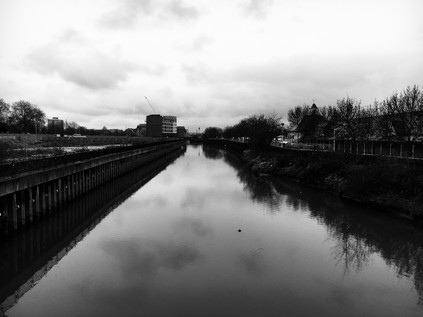
I zig-zagged under the concrete of the flyover and out of Barking, having passed the twin barriers of river and road which separated it from London. From here on, the streets conformed to a victorian pattern of long terraces leading away from the straight road into town. In some ways, this section of my route belonged to my A13 project as the former route of the road had taken this path through East Ham and Canning Town. I realised with some surprise that I was on familiar territory - if from an unusual angle. To the south, Langdon's Academy sprawled along the North Circular - and I recalled striking out along a path edging around it on a previous walk. Meanwhile to the north, the inaccessible scrubland which had barred my way when tracking the Roding south ended in a tangle of unkempt trees and rampant flytipping. I was also crossing into the London Borough of Newham here - one of the proud host boroughs of the 2012 Olympics which seems to be none the richer for its tolerance and hospitality. The road soon gave way to the rows of terraced side streets, named in the Victorian style and with considerable imperial glee for generals, battles and saints. Barking Road was a long-established thoroughfare, no less busy for the building of the new A13 to the south, as it provided access to this vast hinterland of residential streets which marched into the city. I passed the impressive red-brick clock tower of East Ham Town Hall, currently swathed in cloth for repairs but still a landmark on the route into town. Newham Council decamped in 2009 to an anonymous glass hangar on the edge of the Royal Docks in a move which showed a good deal of disdain for the local population which has historically clustered around this area. However, there was a more significant hollow at the heart of this community - a gaping absence where the Boleyn Ground had once stood proudly among the homes and shops. My last interest in football, save for a few notable World Cup tournaments which piqued my curiosity, was on 8th March 1980 when Aston Villa's FA Cup run was cruelly ended in the quarter final by West Ham United. Having listened on the radio in growing disbelief, I remember my hot, perhaps rather spoilt, childish tears of frustration and rage, and a vow not to let this game get me so upset again. I was always an oversensitive soul it seems, but passing a mural of Billy Bonds and Trevor Brooking, I began to understand how this pursuit and the ground which provided a focal point for it had defined this street. With the stands sitting proudly in the midst of this teeming neighbourhood, everything hinged on West Ham - and while it was no doubt the livelihood of many of the local shopkeepers of Barking Road, it was likely the scourge of plenty of locals who wanted a quiet life. The team's ill-fated departure to the Olympic Stadium a year or so back hadn't solved any of these issues and had created plenty more. I vividly remember being evacuated from Stratford on the afternoon of the first match at the rechristened London Stadium - we had strayed in from the industrial hinterlands on a wander around the east, and were swiftly and unceremoniously guided out of the emergency doors and into the Carpenters Estate as a helicopter circled above. The crowds of shoppers dawdling around Westfield were apparently not compatible with a single-minded surge of football fans heading for the hostelries pre-game. On Barking Road, the long parade of shops - the pristinely clean Nathan's Pies and Eels and the Ercan Fish Bar complete with mock West Ham crests - masked the site of the ground, a forest of cranes marking the regeneration efforts. The shops were quiet, pedestrian traffic almost absent. I sloshed along the forlorn street wondering what would become of the businesses here, their ambivalent blessing and curse now gone for good. Would the heritage fetish bring fans back here to their true home, or was it all too late? At the next corner, a statue proudly depicted a cross-section of the 1966 World Cup winning squad, a group of West Ham players who had provided an ongoing engine of national pride which was still recalled in keycodes and passwords generations later - 1066 and 1966 - our defining moments, almost a millennium apart.
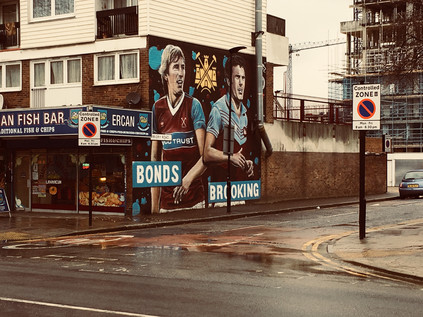
I passed into more familiar territory as I crossed The Greenway, that elusive and strange footpath running along the Northern Outfall Sewer which became something of an unattainable prize during the post-Olympic years when re-opening was often promised but never delivered. At its crossing of Barking Road it is running at ground level, usually with long views both east towards the Barking Flood Barrier and west towards the new towers of Stratford City. Today though, there was a flat grey wall of cloud blocking both views. People emerged from the gloom, trudging along the wet path with their heads down. It was good to see the path busy and used though - this stretch in particular had always seemed like a much missed amenity at times when it was off-limits. It was tempting to swing north and west, to head for familiar old landmarks - but I'd decided to press on into Canning Town to complete the sense of entering the city proper, so I pushed on despite my feet aching from walking on slippery pavements all day. Beyond the Greenway, the ribbon of retail units begins which run for the remainder of the length of Barking Road to an abrupt ending where East India Dock Road leaps over Bow Creek. In the distance I could see the cluster of shadowy towers emerging from the gloom on the Isle of Dogs. The road into Canning Town was in transition - and probably had been for years, likely since the closure of the docks. The resolutely homogenous crowds back in Upminster seemed a world away here where old Indian men shuffled along beside swaggering young men with low-slung trousers and Eastern European women pushing prams slowly along the pavements. A shard of red and black glass pierced the gloom - one of the towers which had emerged from the redevelopment of Rathbone Market. Anyone you asked would tell you it was no good - that the old Ratty had been destroyed by the new buildings and the character and charm was all gone - but the community here had been shifting and changing for much longer. The market they missed was in truth the ghost of the one that had been buried long ago, and the spirit of place which is now much closer to the surface in the satellite towns I'd walked in from. As I joined a bus queue which silently shuffled towards a parade of double-deckers emerging from the darkened eastern skies, I considered the area where I'd finally stopped. This spot united many of my excursions and felt almost homelike in its familiarity. I could navigate from here to almost anywhere in the complex network of rivers and roads which I'd memorised accidentally by a seemingly random pattern of walking and re-walking over the years. This spot marked the end of an unremarkable dark ribbon of asphalt snaking in from the edge of things which had wound a steady course through former towns with roots in prehistory, precious unburied idols and the keen absence of more recently diminished heritage. In the growing gloom of the afternoon I boarded a bus to Aldgate, reversing my incomplete walk out of London to the coast which had begun a long time ago, and crossing the boundary of old Essex as I crossed the River Lea. It had been good to be back out east at last.
You can see more pictures from the walk here.
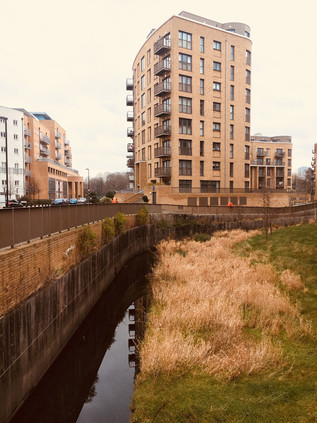
Ill-treated and still hardworking: Walking The River Wandle
Posted in London on Saturday 13th January 2018 at 10:01pm
The turn of a year always generates reflection - and as I sped towards London on an unusual mid-month trip, I realised I'd not slept nearly enough. I was troubled by both physical and mental disquiet, suspecting I'd picked up some sort of minor virus to accompany a strange and unshakeable anxiety that had stalked me into the new year. I was restless to get underway yet simultaneously prematurely fatigued and it was easy, in these conditions, to begin question why I undertake these treks across London, and even if perhaps I should just cut my losses and stop? Too often, when challenged, I cleave quickly to the charge of pointlessness. I wonder if I'm perhaps trying to write myself into the shoes of thinkers and authors I admire, or to moderate others' experiences through my own strange schemes and invalid contrivances - but then I think it's far, far simpler than that. I realise, as my memories of childhood start to idealise a time of stability and simplicity, that I want to turn the map into the territory: the years of solitary wonderment at the pages of the A-Z, the drawing and redrawing of optimal routes across terrain I could barely even imagine. I've needed to be able to make these walks for many, many years. Why London when it's not 'my' city? Because it is no-one's city - and therefore eternally up-for-grabs. A tangled, dark mass that feels unknowable, but of which millions can picture their tiny corner in minute, local detail. A city where one can still discover things afresh and stumble into novelty unexpectedly, but also where thousands of years worth of sometimes dubious clues to the undocumented treasures have been laid by prior travellers. As I step off the train at Paddington and start a zig-zagging bus and rail journey south towards Croydon, I resolve to keep walking at all costs whether anyone is reading or not...
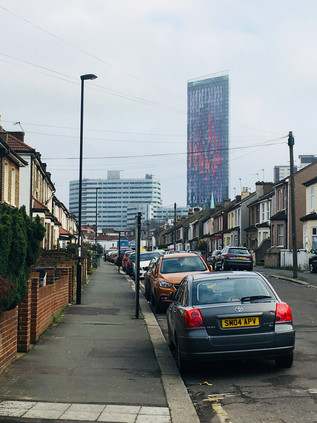
Curiously, a former colleague had been in touch during the week as I'd planned this walk - he sought an introduction to someone who could help him with a project he was beginning at the London Borough of Croydon. The footer of his email dispensed with the legalities and declared simply CROYDON in bold font, mimicking the Mayor of London's own block capital strapline. However, I stepped out of West Croydon station into a decidedly lower-case tangle of unruly buildings running along the edge of the railway. In particular, a glowering, red-brick Victorian shopfront faced me from across the street and channelled me towards a crossroads where the more salubrious shopping areas began. I hadn't strayed into Croydon in years - and when I was last here it was a fleeting visit to cover the new tramlines. The reality of Croydon was both more interesting and much more confusing than it had appeared from the windows of a tram - a modern city centre imposed on an overgrown suburb as a mid-century modernist project, with the second generation of new glass towers already striking against the dull January skies. A forest of cranes signalled the ever-present redevelopment, while my route west lay between terraces that could comfortably have been resettled in Nottingham or Edgbaston. The town was divided by Roman Way - a sweep of dual carriageway elevated to clear the railway and tramlines heading west from the centre and named for the disputed presence of the ancient route between London and the coast. Assumed to branch from Stane Street at Kennington and ploughing south through the Caterham Gap to cross the Low Weald, the existence of the road is based on fragmentary evidence - pieced together tracks, flint beds robbed for turnpike surfacing, and Anglo Saxon street-nomenclature along the way. It is comforting to feel anchored into the past though, as Croydon had an indistinct and impermanent feeling this morning. From the rapid cycle of demolition and rebuilding in the centre to the futureless and stateless people awaiting their fate at Lunar House, the nearby Immigration Compliance and Enforcement office, nothing felt like it was permitted to contemplate its future here yet. Croydon floated uneasily over the headwaters of the River Wandle. In the much-misused gazetteer of the Royal Mail's postcode directory, the centre of most major towns and cities is always 1 - the primary zone. In Croydon, it is an absence - CR0. Ground zero for both the river and the city was the same patch of boggy marshland. As I shuffled under the main road and headed for the water, I noted the road was appropriately named 'Pitlake'...
A short tramp through the suburban backstreets of Croydon brought me to the first of several Wandle Parks I'd visit today. Formerly two marshy fields - Froggs Mead and Stubbs Mead - the area was drained and established as a public facility in 1890. The River Wandle makes its first public appearance here nowadays. Despite being culverted in 1967 due to regular drying-up and appalling water quality, environmental improvements in that heady project-obsessed Olympic summer of 2012 saw the river uncovered and allowed to wander across the southwestern corner of the park as an enhanced public amenity. The stream begins to gather strength under the streets of Croydon, where seasonal streams or winterbournes from Caterham and Coulsdon merge to form a sizeable, relatively clean flow through the park, before disappearing again under New South Quarter, a surprisingly decent but depressingly predictably named development of new homes which hugged the course of the river with excellent access to the nearby Tramlink stop. Having crossed the tramlines I was forced to navigate the crescents of the development, feeling ill-at-ease in the domestic business of the obviously private zone but equally pleased to see the river cleverly managed into the development. The Wandle curved reedily and silently in a deep channel which bisected the development, before disappearing from view again to pass under Purley Way and the run of vast retail sheds which are slowly reclaiming large zones of former industrial brownfield vacated by the vast Croydon Gasworks. As I passed by an apparently recently opened John Lewis at Home superstore I reflected on this area - once largely empty marshland, fed by the remarkably fickle waters which make up the Wandle - streams which rose and fell with the season, sometimes disappearing entirely and then returning as a fatal tumult when heavy rain fell. On the northern horizon two chimneys towered over the low-rise retail landscape, remnants of Croydon's municipal power station which fed the street lighting locally until surprisingly recently and utterly complicated its renewal. The tall stacks are marooned in an Ikea car park, surrounded by a newly laid pattern of streets which crackle with false memory: Volta and Ampere Way surround the store. They make a striking mark on the dull wintry sky - and there is always the temptation of strolling north for a picture - but I'm painfully aware of the risks the amateur explorer faces in lurking in Ikea car park. At best, arrest is possible - at worst, perhaps trespassing on a trademark?
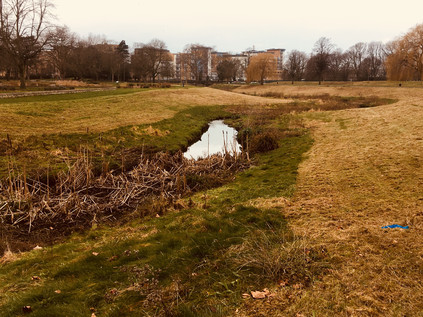
At a rather gloomy crossroads I turned west again onto Mill Lane, one of many streets in the Wandle valley with a similar name, giving a hint to the nearly constant industrial uses of the river. By the late Victorian era, the waters turned the wheels at over ninety mills between Waddon and Wandsworth, many of which had existed from time immemorial. The Domesday Book mentions a flour mill at the northern end of Waddon Ponds which remained operational as late as the 1870s but which was finally demolished in 1928 and has apparently now been replaced by a strangely ornamental modernist multistorey car park marooned among the grimy, crumbling factories of an early 20th-century industrial estate of the type which fanned out along London's arterial roads. Access to the ponds was forbidden - further work was underway to make the green spaces around the river accessible here. A narrow path apparently once known as Brandybottle Hill climbed beside the line of trees which marked the edge of Waddon's backstreets, and soon the river was overground once again, flowing west into the exclave of Beddington Park which stretched east towards Croydon. I hedged my bets on walking the southern bank of the river here and soon found I'd possibly taken a wrong turning already, emerging on a narrow residential street simply called 'Bridle Path'. But as the rather quaint street wound north and west I was surprised to find myself walking alongside another brook which appeared on an older map to be the established line of the Wandle, divided here to power a Snuff Mill with an underground sluice still regulating the waters. The now more minor brook crossed under Hilliers Lane, emerging again into Beddington Park to rejoin the branch of the river which I'd lost track of a few streets before. Not for the last time today had the Wandle's indecision and bifurcation confused me. Walking in the park was quiet and pleasant, but my physical condition was taking its toll already. I slogged along the northbound path towards the Pavilion Café in the hope of a brief rest, but I found it already overspilling with the families of junior football players who were taking part in a Little League tournament nearby. I turned southwest instead, striking out across the wet grass of the open park towards a knot of trees indicating the course of the river. The huge expanse of green space here is a remnant of the Carew family estate - formerly a deer park with their home and the village church neatly squared away within acres of parkland which still has a curiously rural feel today. The house remains in the midst of the park, an impressive formal Tudor manor that now serves as a Special School. The Carew family finally left the area in 1859 after a turbulent few centuries which saw them fall in and out of favour with the royal court. In 1538 Thomas Cromwell seized the hall and lands from Nicholas Carew whose popularity had apparently begun to irritate the notoriously easily rankled Henry VIII. The family found more stable patronage under Queen Mary with their lands in Beddington restored to Francis Carew who perhaps advisedly took to carefully improving the gardens and lands around the hall rather than attempting to further make a name for his family at court. After the Carews departed the building became a 'Female Orphan Asylum' before slowly progressing towards its current purpose. Close to the house, the confusingly named Canon Bridge's Bridge spans the Wandle, a low red-brick decorative parapet memorialising the Rector of the nearby church from 1864-91. I regained the footpath in the hope of walking beside the lake in Grange Gardens where the Wandle broadens to form yet another former millpond - this time for a long-closed paper manufactory, but I was soon thwarted by more improvement works and found myself unceremoniously booted towards the main road a little north of the gastropub which now inhabits The Grange. After passing under Wallington Bridge the river disappeared between suburban back gardens, and I needed to decide where the head next...
By now I was realising that understanding the historical or geographic journey of the Wandle was far from a simple task and as I headed south again into the former village of Wallington, which now seemed to consist of little more than a permanent traffic bottleneck, I noted the shallow rise of land to the west which divided two branches of the headwaters of the river. The branch I'd followed from Croydon now turned north, but there was a western stream rising at Carshalton Ponds which lay a short climb away along Butter Hill. This stream is The Wrythe which gives its name to the tiny hamlet-like settlement which sits north of Carshalton, retaining curious isolation from its surroundings in no small part due to the natural boundary of the river. As I descend from the twisting course of Butter Hill to pass under a low railway viaduct the stream appears beside the road, a busily bubbling green-fringed channel which runs almost unseen towards the nature reserve at Wilderness Island where the branches of the Wandle finally meet. They tumble together at a weir that disappears under light industrial units built on the site of a former leather mill. Looking back across at the damp, green shore of the island, it seemed a miracle that it had survived so relatively unscathed among the industrial and residential developments which crowd around the Wandle - and perhaps more remarkable still that the river has remained above ground for much of its course to the Thames. The path emerged onto Hackbridge Road, the original site of this tiny village having apparently almost entirely succumbed to more of the drab industrial shacks which seemed to populate every spare corner of land around here. The centre of the village, such as it was, had packed up and moved northeast to meet the railway - my path was quiet and my walking uninterrupted. Except, that is for swarms of midges which by my reckoning shouldn't be out here in January. As I skirted the edge of Watercress Park - named for the naturally occurring crop which was harvested and indeed cultivated along the river until pollution made it entirely unsafe - I found myself plunging into a cloud of flying insects which it was impossible to avoid inhaling and swallowing. It's a reminder that this was once a significantly broader expanse of marshy wetlands, and that it is only relatively recent development that has penned the river into a narrower and less complicated course - but there is also a troubling signal that seasons aren't quite how they ought to be nowadays, and that a cold and damp January day feels almost like March.
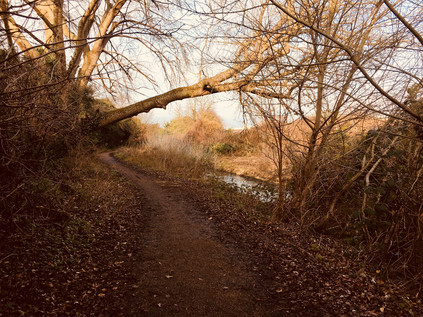
At this point on my journey I realised with some surprise that I'm in a part of the city I barely knew, and of which I hardly even have a mental map. I've passed above this landscape many times on trains and trams and even changed at stations nearby, but I have only the slightest grasp on the geography. Years of walking in the north and east provide me with frequent shocks of recognition as the familiar districts tessellate satisfyingly together, their landmarks appearing on cue - but here in the south, I was as close to being lost as I've been for a long time. The river provided a constant guide, but the whirl of Morden, Merton and Mitcham around it didn't yet make any sense to me. I figured it would come in time. My meandering route between the headwaters of the river earlier in the day also meant that I was barely further north than my starting point at West Croydon and apparently only a little further west. The land here seemed to remain divided on some long-observed strip system - a long ribbon of industry running close to the river, then to the east a broader stripe of wasteland and open space, much of it scarred by past use for landfill and waste processing. On the western edge of these zones, the river persists, running through reclaimed parkland and frequently dividing into abandoned millstreams and drainage ditches before recombining. The water also seems clean despite a surprising amount of unidentified and ominous-looking pipes and gullies dribbling into its course - though as I pass through Poulter Park, named for Harry Reginald Poulter - a local architect of the early 20th century, a large lifeless fish stares up, empty-eyed from the stony river bottom. The Wandle has been abused for centuries, and more than once named the dirtiest water in London. While it is arguably cleaner now that for many decades with much of the filth-producing industry which once blighted it now disappearing, in common with other urban rivers it faces new challenges from misdirected domestic drains and surface-runoff. At the edge of Poulter Park, I take a wrong turning and find myself walking the scrubby, overgrown path on the perimeter of Watermeads Nature Reserve rather than the recently improved path beside the river. This sliver of wetland remained off-limits to most of us until 2015, having once been home to four mills and a trout stream until it was purchased by the River Wandle Open Spaces Committee in 1913 and its management vested in the National Trust in memory of Octavia Hill whose efforts to protect green spaces like this 'ill-treated and still hardworking little river' inspired the local burghers. While public access to the river and wetlands is now much improved here, my route between the drainage ditch and the high wire fence of the neighbouring gym wasn't nearly as pleasant. The unmistakable smell of human waste drifted from the ditch in clear evidence of a drainage problem nearby, and the midges were back with a vengeance in this fertile breeding ground. Already feeling sick and tired, I wondered again at the wisdom of taking this walk today? The miasma and associated wildlife dogged me into Ravensbury Park, an otherwise attractive green space which seemed to be a chosen hang-out for small groups of glowering youths tossing spent Relentless cans into the river and practising looking as furtively urban as possible in Collier's Wood - an otherwise quiet and apparently fairly well-to-do sector of the suburbs. I kept a straight face as the youngest, whitest member of a group inexpertly and solemnly flicked a cigarette end away while referring to his equally pasty-faced colleague as 'blud', before carefully crushing the butt with the toe of a gleamingly fresh Christmas present trainer. I wasn't sorry to emerge onto relatively dry land and to follow the road a little way along the walled gardens of Morden Hall Park. Even this diversion didn't take me far from the water as the wall ran beside a millstream that flowed west from the mainline of the river. It's easy to assume the wide, green spaces of Morden Hall's extensive deer park are ancient in origin - but they date in fact only from the relatively recent 1770s. While records indicate that an earlier house seems to have existed here, this rather grand home of a Tobacco Merchant is testament to how recently the southern suburbs have grown on the back of the emerging middle-classes and their industry. Even a hundred years after the building of the Hall it would have delighted in a rural location with very little development around it despite the railway running along the eastern edge of the park. Now a National Trust property with a profitable garden centre and café on site, the main Hall is an exclusive wedding venue - though a number of interesting survivals are maintained in the park including a watermill formerly used to process tobacco. A large area of the grounds close to the eastern edge of the site has been returned to wetland, and after swiftly crossing the churning A24 to purchase refreshments on Merton High Street I headed back into the park to regain the line of the river by way of the Boardwalk, a reassuringly solid wooden walkway which zig-zags around the wetland landscape, reminiscent of the Marsh Trail I'd encountered in Seattle. I paused at a quiet spot on the boards to take refreshment and to enjoy the reflections of steely skies and tall reeds in the silvery waters while an intrepid photographer splashed and clambered around finding unusual angles on the scene nearby. Setting off again, I crossed the Tramlink line to Wimbledon and set out along a long, apparently canalised section of river which was stalked by the ubiquitous line of pylons which I never fail to encounter when walking near rivers. The landscape I was walking through now set the scene for much of the rest of the river's journey - a broad and sluggish river running quietly and anonymously behind crumbling industrial sites on its slow progress north. Perhaps the Wandle had only survived intact because it appeared to have entirely slipped from the minds of those who live nearest to its waters?
Given the entirely practical approach to the Wandle taken by industry, a perhaps surprising survival alongside the river is Merton Abbey Mills. This complex of former mills and factories on the site of Merton Priory has a remarkable place in the history of British textile manufacture. Merton Priory was destroyed during the dissolution of monastic properties in 1538, having been a seat of ecclesiastical learning since 1114. During the tenure of the Priory, both St. Thomas of Canterbury and Nicholas Breakspeare who became Pope Adrian IV studied in its precincts. The priory has a solid civil history too - and the Statute of Merton, enacted at a parliament summoned at the priory by King Henry III in 1235 is the oldest recorded English parliamentary statute. By 1667, textile manufacture had begun at the mills on the site of the former Abbey, and soon refugee Huguenot silk weavers were working at the Mills, with calico printing also taking place from the mid-eighteenth century. This was clearly a consideration for William Morris who located the textile printing works of Morris & Co. on the site in 1881, employing weavers from Spitalfields who were still regarded as the pinnacle of the profession. Liberty & Co. joined Morris at the site in 1904, with both businesses using the Wandle's waters and the wetlands nearby to grow dye plants for the high-quality fabrics. In 1940, Liberty took over the Morris works and continued to produce their designs on the Abbey Mills site until 1972. Some smaller traders hung on to the tradition, but by 1982 however, all textile production at Merton had ceased. In an appropriate rebirth though, this historic corner of the Abbey Mills site remains a cluster of workshops and buildings now given over to craft stalls, restaurants and entertainment venues. The only remains of the very comprehensively destroyed Priory buildings are located in a foot-tunnel under the road which leads pedestrians to the huge retail complex on the banks of the Wandle. I stayed above ground, following the broad curve of the river around the gigantic silvery flanks of a Sainburys/M&S megastore before passing under a contemporary reconstruction of the Abbey gateway and into the quiet and aptly-named terrace of Wandle Bank which ran the length of Merton Bus Garage, home to London General. Buckling tree roots and cars parked haphazardly made walking along the railings beside the river a challenge, but I was able to amble along the middle of the quiet backstreet, sticking close to the now wider and slower-flowing river.
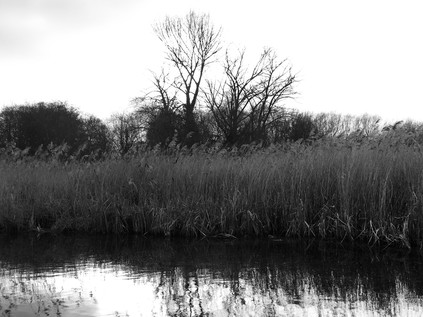
At Bewley Street, a development of recently-built apartments had resulted in a brief section of freshly-made footpath along a particularly pleasant, tree-hung stretch of the river. Beyond the trees, the concrete ghosts of the Wandle Valley Storm Tanks marked the only remaining evidence of the huge sewage works which dominated this section of the river from 1877 until 1970. A stocky wooden footbridge crossed the river nearby, descending into a wide span of pleasant edgeland between road and railway. There had been a plan to build a new stadium for Wimbledon Football Club here for many years, one of fourteen sites in Merton which the club had considered and rejected before finally decamping to Milton Keynes in time for the 2003 season, forever severing ties with the area. Considerable pressure from local residents and the fact that this riverside site would share many of the frustrations which the club already endured at the Plough Lane further downstream site meant this site was soon discounted, with the plans abandoned by 1989 when Merton Borough Council designated this area a nature reserve. It seems likely that prior to purchase for use by the waterworks the land would have been water meadows, and slowly the site is returning to nature with the ribs of concrete under the grass slowly disappearing and the trees along the river beginning to obscure the bank from view. Weak but persistent sunshine reflected from the rank of pylons which ranged along the valley floor, and I felt like I was on more familiar walking territory here as the path left the river and headed briefly eastwards to navigate a graffiti-adorned low underpass beneath the loop of the Thameslink lines from Wimbledon to Sutton. Turning west again to skirt a sliver of industrial land between the railway and Lambeth Cemetery, the path shadowed the tall, moss-covered concrete retaining walls that enclosed the final metres of the River Graveney deep below. The Graveney met the Wandle at a rather curiously placed viewpoint which strode out onto a platform on the thin tongue of land between the rivers, suspended above the water. I didn't linger here as I was aware I was nearing one of the few spots where I'd encountered the River Wandle before, almost fourteen years ago in January 2004 in fact, when I'd trekked out to Lambeth Cemetery on the heels of William Kent. I recall the uncertain walk into the strange, semi-industrial zone east of Wimbledon, along Plough Lane, and over the Wandle where I was now standing. Little had changed, the area was still a mess of pylons and prefabricated warehouses, with the corrugated iron flank of Wimbledon's doomed greyhound and speedway stadium still clunkily overshadowing the north side of the road awaiting demolition. I crossed the road, dusty from passing commercial traffic despite the recent wet weather, and disappeared along the riverside path separating the water from the recently built residential development which had appeared at some point in the last decade or so on the vacant land which had once accommodated the football stadium, already demolished before my first visit. It felt strange after a day of almost entirely alien scenes to recall a moment on a much earlier walk so vividly. The path here was easy to walk and the weather had improved to the point that there was blue sky overhead. I'd begun to feel a good deal better, and despite feeling tired I had the first inkling that actually I could manage the whole of my planned route despite the challenges. The Wandle was a sluggish green now, a strange combination of the weedy riverbed and the reflection of the overhanging trees - but it also recalled my very earliest association with the River as a mysterious presence in Michael de Larrabeiti's Borribles trilogy. I've written before about the effect that this oddly grown-up take on a gothic urban fantasy had on my view of London, with a gang of lawless children who have been freed from the shackles of parental responsibility using the River as a highway of sorts through the territory of rival factions of city denizens. I've also written before about how this chance walk reignited a strand of exploration which continues even now...
Once the Wandle had been a pleasant stream, but years of industrialization had turned it into a treacherous ooze of green and muddy slime, a mixture of poison waste, decomposed rubbish and undigested lumps of plastic which rolled slowly along the river's surface as it slid like a thick jelly down to the Thames.Michael de Larrabeiti - The Borribles - 1976
This curious tale - a sort of warped analogue of the pastoral, environmentally-friendly Wombles who stalked a fictional version of nearby Wimbledon Common for stray litter - had a strange and lasting effect on me. Not least in the idea that there were other rivers in London, and that they might not be well-trodden or widely known, but that they led somewhere, and had a purpose. The final book in de Larrabeiti's trilogy - Across the Dark Metropolis - pitted the army of mischievous and sometimes amoral child-creatures against a dystopian reimagination of the Metropolitan Police force, which may not have been too far from the now emerging truth of South London's corrupt and lawless coppers of the mid-1980s. It was though, all a little too real and present for his publisher who just days after rioting culminated the killing of PC Keith Blakelock at Broadwater Farm decided that "the present climate of urban Britain is not the climate in which we would wish to publish this book". It finally emerged a year later, and of the trilogy perhaps best captured his unapologetic revolutionary Socialist response to the division and inequality of London in the Thatcher years. De Larrabeiti died in 2008 - a champion of the underling to the end. It's tempting to hope that despite witnessing a new age of inequality beginning to divide the city, he also lived to see the green ooze of the Wandle flow clear again. Certainly the London his characters stalked in the mid-1970s is largely now hidden from view - unless of course, we decide to explore these dank river trenches and hidden culverts where the past is never far from the surface. I'd like to think that despite different political approaches, my own explorations honour his ability to make the commonplace mysterious and interesting.
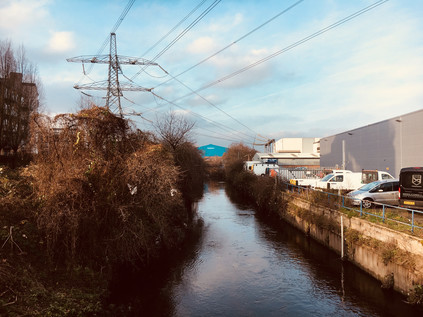
The path continued, with the river winding towards the Thames through more industrial zones which served to divide Wimbledon from Earlsfield. As the afternoon had turned a little warmer and I had finally settled into the rhythm of the terrain I was rather sorry that I was approaching the last leg of the walk. The path was mostly deserted and the calm churn of the river as it passed by silent factories and yards closed for the weekend and lapped under tumbling sheds overhanging the riverbanks from their allotments was, at last, relaxing me. Before long the path took me over a footbridge and dumped me unceremoniously onto the backstreets of Summerstown, where the boroughs of Merton and Wandsworth face off. This tiny suburb has largely been written out of modern maps, but in 1913 when Edward Thomas made an epic cycle journey from Clapham to the Quantocks - he saw the curious contrasts of the rural and industrial faces of the Wandle clearly:
The main part visible was twenty acres of damp meadow. On the left, it was bounded by the irregular low buildings of a laundry, a file and tool factory, and a chamois-leather mill; on the right by the dirty backs of Summerstown. On the far side a neat, white, oldish house was retiring amid blossoming fruit trees under the guardianship of several elms, and the shadow of those two tall red chimneys of the electricity works - A mixture of the sordid and the delicate in the whole was unmistakable.Edward Thomas - In Pursuit of Spring - 1914
The discontinuity in the Wandle Trail footpath has been on the radar of Merton Council for years, but as the river heads off under the railway and into the pattern of suburban streets here, it's difficult to see how a path close to its line could be found even by the most determinedly community-minded of local authorities. Instead, I'm directed into busy Garratt Lane - Earlsfield's de facto High Street. The usual, ubiquitous coffee chains clustered around the station entrance among some unexpectedly high-end local stores which were perhaps not the image of this part of London which I'd carried with me for years. It was tempting to linger here and attempt to understand how this part of the city ticked, but I was close to my goal now and despite aching feet, I thought I'd be able to make it to the Thames. I turned west again after passing under the railway and found my way into King George's Park where the River soon reappeared on the eastern edge of the space, close to the backstreets of Earlsfield. The sun was beginning to sink low into the western sky, but the break in the relentlessly bad weather of the last few weeks had coaxed out a good number of families who were walking and playing in the well-kept park. The five tower blocks which flanked the Southside development cast long shadows as I walked towards them in order to get my last glimpse of the Wandle before it disappeared under the centre of Wandsworth. The river has been straddled by development here since 1971 when the Arndale Centre opened, spanning the waters and regarded in its day as something of an engineering miracle. At the time, the Wandsworth Arndale was the largest indoor shopping centre in Europe, and it contained a mix of housing, retail, offices, a large indoor market hall and even a nightclub. The centre declined in popularity in the intervening years as anchor tenants Sainsbury and Tesco decamped to larger, purpose-built premises nearby leaving the all-too-familiar pattern of shuttered units and 'value' stores which has blighted a number of centres of a similar vintage. The centre struggled on to the turn of the century, until a comprehensive modernisation and redevelopment began in 2004, largely now complete despite setbacks due to the economic downturn. Little of the original 1971 fabric remains evident aside from the contemporary residential towers which dominate the Wandsworth skyline from all directions. I caught my last glimpse of the river here at Mapleton Road, balanced on a tiny pavement with a steady traffic of bus passengers tramping by seemingly unaware of what lay beneath their feet. The stream divided, flowing swiftly and darkly into two concrete tunnels under the building. Above the river a car park access road disgorged vehicles from a similar opening in the building, the river largely forgotten by the motorists queuing to escape Southside. Turning north into Garratt Lane again, I was shocked by the press of people which I faced. While the walk had been far from solitary by my standards the crowd of shoppers, eyes fixed on the bargains and attention diverted from their immediate surroundings, was more of a challenge to navigate. I weaved and slalomed my way to Wandsworth High Street, swiftly crossing and delving into the hinterlands behind the Ram Brewery to escape a busy Saturday scene. The redevelopment of the brewery and the riverbanks beyond continued behind hoardings decorated with hyper-real scenes of future Wandsworth - everyone seemed happy in these artists impressions, and just like now the river appeared to be ignored entirely by the device-absorbed couples wandering the unreal new world projected on the barriers. It was good to be away from the tide of present-day people blundering around the shopping area, and the landscape north of the High Street gave a tantalising clue as to how the area may have looked as recently as the middle of the last century. The maritime air of the place was evident, with long brick walls and low sheds running along the muddy creek to which the Wandle had given way for its final few yards. I turned into a narrow, curving street reassuringly named The Causeway and tried to ignore my fatigue for just a little while longer.
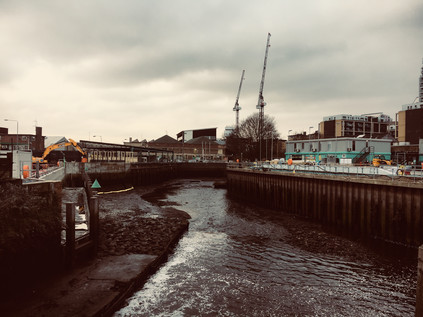
After crossing the point where the river divided, with Bell Lane Creek forking muddily to the west and Wandsworth Creek - sometimes obscurely known as Frying Pan Creek - to the east, the Causeway became a footpath onto a tiny sliver of land which sat in the midst of the two streams. Near this point a tidal bell hung, activated by the rising and falling of the river and ringing four times each day - but sadly not at the time I was passing by. The land here had an impermanent and shifting feel, with the Wandle's marshy delta coerced into the narrow channels between high flood walls and muddy banks. The Causeway originally linked Wandsworth Plain, the site of the original settlement here, with the river and would once have been a busy route between the Thames and the village. Today it was near-silent, and as I tramped on, the smell of the tidal river began to replace the fumes of the nearby A3. Beside the creek the huge Western Riverside Waste Authority's works brooded, quietly dominating the waterfront here and diverting the riverside path inland to accommodate a wharf for offloading refuse. The area occupied by the depot had once been water too: In 1801 the Surrey Iron Railway Act authorised the construction of a basin connected to the Thames and running as far south as Wandsworth High Street at a spot known then as Ram Field. Freight would be transferred to ships from railway wagons here, which had begun their journey from "a place called Pitlake Meadow in the town of Croydon" - the start of my walk today. The original plans had favoured the proven technology of a canal for the entire distance, providing a bypass around the numerous mills that blocked the Wandle to navigation, but surprisingly the plan for a cheap and somewhat poorly built railway prevailed. The line was never successful and it's poor construction standards necessitated frequent mending of rails broken by the weight of loaded wagons. By 1848 the railway was being removed, the company having been unsuccessful in attempting to sell it to the London Brighton & South Coast Railway as an extension to their growing network. The canal basin found a second life when, in the ownership of the McMurray family, it began to serve a paper mill close to the site of the modern-day shopping centre which continued in operation until the 1920s along with providing access to the Ram Brewery. Sections of the canal basin appear to have begun to be filled in to accommodate new industrial buildings during the 1930s and by 1956 the basin had disappeared entirely from the map, only evident in the presence of a bridge parapet pointlessly lifting the railway over an expanse of the car park which had once been the wharf.
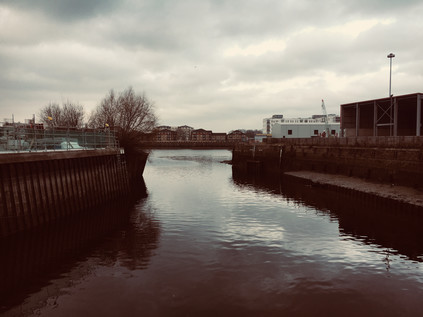
The causeway path led out onto the narrow tongue of land where a generous bench faced out onto the Thames beside Sail, Sophie Horton's blue steel sculpture which formally marked the end of the Wandle's journey. On the bench, a young man was having an apparently animated and frustrating telephone conversation, which he'd clearly thought would be private out here at the confluence of the rivers where no-one much seemed to come, at least on a January afternoon. He eyed me with dismay and mild disgust and wandered back towards dry land leaving me to rest alone on the ship-like curve of railings and to contemplate my walk. It had sometimes felt unlikely that I'd finish today's trek - despite the distance not being challenging on paper at least. The tired, sick feeling which had stalked me lifted briefly with the satisfaction of completing the walk but soon descended with a vengeance as the sky churned into a grey-black threat which the brown tidal waters couldn't adequately reflect. The muddy creek which flowed out to the Thames seemed a far cry from the bubbling brook which had twisted across the parklands of Croydon but did at least fit with the menacing Wandle of unctuous and deceptive green sludge which had first intrigued me in Michael de Larrabeiti's writing. I recall being a shy, quiet child who had lived out these adventures purely in my mind, marvelling at parts of a city that I didn't expect to ever see. Somehow being out here, at the mouth of the river which felt like the spark of a thirty-year obsession was a special moment, and one I was a little surprised I'd not sought out before. The mysterious southern rivers felt like a new project for a new year, one to be savoured and filed between excursions in less alien territory. My prejudice in favour of the north wouldn't easily be overcome - but now I was sure there was a reward in persisting.
You can find more pictures from the walk here.
The last few weeks of the year felt like a bit of an epic slog, and only the prospect of the long break we'd planned over the festive season kept things on an even keel. In recent times, we've fallen into a very pleasant pattern at this time of year - a quiet Christmas, a small gathering at home for New Year, then away on a road trip on the first day of the new year - a week when everyone else is unwillingly slogging back to work. It has worked remarkably well - hotels offer up rooms at ridiculously low rates in the post-festive slump, and if you don't mind short days and sometimes unpredictable weather, then it's a good time to be away - a brave attempt to stave off reality for another week perhaps?
Our trips also have a familiar pattern - up the west coast, the long straight arm of the M6 stretching into northern regions which still feel oddly exciting and wild to me, just like my earliest rail journeys along the remote and sometimes otherworldy main line. We pause on the journey north for a night - often somewhere in Lancashire - to maximise daylight driving, and to rest on what sometimes feels like an epic northern journey. This time our staging post was Liverpool - a city we've visited before, but this time we headed north out of the city in a sudden downpour, towards Stanley Dock. The grid of streets here hasn't seen much redevelopment - the sounds of the much diminished but still busy docks at Bootle shudder through the high walls which surround former smaller basins along the Mersey shore. The landscape is predominantly decaying industry with the occasional tile warehouse or shabby dockers' pub crumbling into the stones. Amidst all this is the Titanic Hotel - a vast, converted warehouse which squats on the northern edge of Stanley Dock. Inside the warm and spacious building a beautiful refurbishment built around the maritime history of the City had transformed the huge space into a comfortable and welcoming hotel. We were almost sorry to just be spending one night in the huge room with a view north across the docks to the mouth of the Mersey.
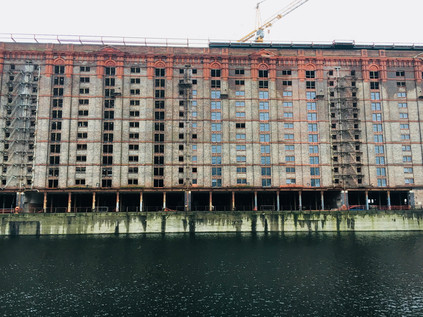
We set off in the morning and headed back onto the M6 for the journey north to Glasgow, breaking our trip at Abington where the flock of crows which has stalked the service area on two prior visits wasn't to be seen. We were staying for two nights - testament to the success of my gradual reintroduction to Glasgow following a despair-filled visit two years ago. Cruising into the city on the elevated carriageway of the M74 as it curved towards the Clyde, it was impossible not to feel lifted by a return to this place which has long served as a second, northern home to me. The glass towers sparkled in the damp afternoon and the trains shuttled along the bridge high above the river. It was good to be back, and after some confusing changes of room - handled impeccably by the hotel - we found ourselves in a wonderful spot overlooking the roof of Central Station, which reminded me of a visit long ago when the hotel was still a creaking, tired and menacing place with its long corridors stretching endlessly along the wings of the station. A return to Glasgow meant a chance to become tourists again, and we visited the People's Palace - a grave omission from my previous trips when I'd only stepped into the building to use the public facilities. The museum remains in the ownership of the city - an honest and frank appraisal of the rapid rise of the city and the problems that brought, and a celebration of the language, culture and political activism which are never far from any discussion of Glasgow. Afterwards we stepped into an old haunt, The 13th Note - but our quiet drink was disrupted by an ultimately harmless but persistent local who had turned up and seemed to be working the bar for a chat. His prodigious drunkeness though, lost it's charm and shortly after he was moved on - so did we. It was tough to leave the place again, especially in such strange circumstances.
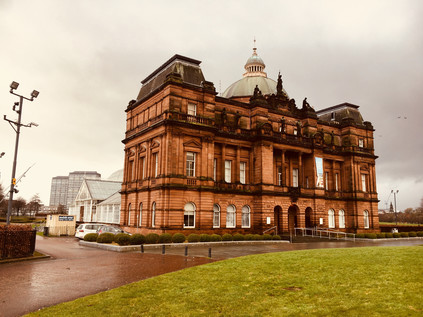
Still repeating our itinerary from previous trips, we next headed through to Edinburgh using the finally completed M8 to swiftly cross from city to city. We'd changed our routine a little for this visit by staying in the New Town opposite North Bridge, with views over Waverley Station and the Castle to the south. It seemed a little strange to abandon the Grassmarket and not to experience the bracing climb up to the Royal Mile each morning, but the new location was a surprising win - affordable and decent accommodation which looked directly into the unattainable windows of The Balmoral across the street! A persistent rain set in a little after we arrived and stuck around for much of our stay - but it was still good to be back in Edinburgh. We headed out to our favourite restaurants and wandered Princes Street, along with a trip to the Scottish National Portrait Gallery housed in a remarkable building and home to a surprisingly varied collection. Edinburgh once again proved to be a relaxing and interesting spot, my old prejudices challenged once again by the city as it sparkled in a light dusting of snow spied from our window over Princes Street. It wasn't easy to leave at all.
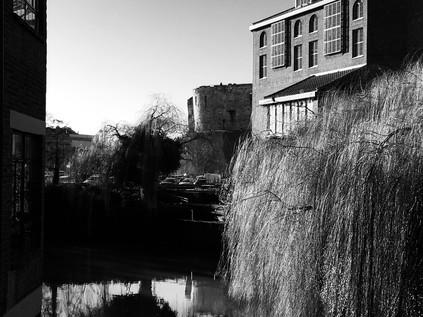
Our final destination, after a long haul down the coast on the A1, was York - and again while a favourite location, a new prospect for our accomodation. However, it was to prove an odd and frustrating place. It's fair to say that Hotel Indigo's rooms were beautiful, but getting into the room was a painful process. A parking set-up that defied logic and seemed to require quantum physics to obtain a spot, followed by a check-in process operated by a corporate robot which had less charm and more inflexibility than an automatic check-in terminal was our introduction. The restaurant was even more of a challenge - the concept of Yorkshire Tapas essentially meaning that it was impossible to tell what was a main course, what was a starter and when the dishes would arrive. The staff, young and inexperienced, dashed from one calamity to the next - finally presenting me with a blank sheet of paper to sign when the till crashed.
And so our trip ended on something of an odd note - a fine week of travel, of old haunts revisited and new ones discovered - but with something of a flat last day dealing with the hotel. At the very least we came away with a stock of anecdotes, and the room was truly very comfortable. We've been exceptionally lucky on our trips so this is to be perhaps marked up as a minor irritation and an opportunity to vent on Tripadvisor. We head into the new year, and hopefully new travels, thankful for this all too brief interlude. For a few days at least, when I close my eyes to sleep I see the white lines of the road stretching ahead. I always dreamed of road trips as a child, imagining cruising the idiosyncrasies of the British Motorway System. I'm finally getting to do just that.
There are a few pictures from the trip here.
Lost::MikeGTN
I've had a home on the web for more years than I care to remember, and a few kind souls persuade me it's worth persisting with keeping it updated. This current incarnation of the site is centred around the blog posts which began back in 1999 as 'the daylog' and continued through my travels and tribulations during the following years.
I don't get out and about nearly as much these days, but I do try to record significant events and trips for posterity. You may also have arrived here by following the trail to my former music blog Songs Heard On Fast Trains. That content is preserved here too.

